The Kitt Peak National Observatory is of significant importance and interest to scientists, community members, and visitors. Located 56 miles southwest of Tucson, Arizona KPNO is home to the most diverse collection of astronomical observatories for nighttime optical and infrared astronomy and study of the Sun in the world (NOAO).
Search for Ideal Location
In the 1950s observatories in the US were all run by private institutions that only allowed their hired astronomers to use the equipment. They were small and mostly located in the east where snow or rain obscured observations of a large portion of the year. Several other circumstances, such as the progression of the Cold War, prompted scientists from different universities to petition the US government to establish one large national observatory (Ramon-Sauberan 2018).
 Hour long exposure at KPNO (NOIRlab)
Hour long exposure at KPNO (NOIRlab)
Then the search for a location began. It was led by astronomer Helmut Abt, astronomer who later became the first director of KPNO Aden Meindel , and engineer Harold Thompson. The ideal site for this new observatory would be far enough from city lights that the sky would not be affected by them, but close enough to an urban area that had materials to build the observatory. It would also be between 6,000-8,000 feet elevation with clear, dry skies. In 1955 Abt flew around the Southwest in a very small plane to look for suitable mountains. He covered 2,000 miles in three days and was able to narrow down potential locations to five sites: Kitt Peak, Hualapai Mountain near Kingman, Chevelon Bette near Winslow, the Sierra Ancha north of Roosevelt Lake, and a site near Flagstaff. After observing weather patterns and other considerations the team concluded that Kitt Peak was by far the most suitable site (Ramon-Sauberan 2018).
 Dr. Helmut Abt (NOAO)
Dr. Helmut Abt (NOAO) Dr. Aden Meinel (NOAO)
Dr. Aden Meinel (NOAO)
In March of 1956 the team was granted permission from the Tohono O’odham Nation to ride up Kitt Peak on horseback. They were led by two Tohono O’odham guides, Al Martines and Raymond Lopez, who explained the importance of the mountain, their creator I’itoi, and cultural perspectives of the land. After the trip up Kitt Peak the astronomers met with tribal council elders who governed the Nation and consulted with the local Schuk Toak District Council (Ramon-Sauberan 2018).
In 1958 the Tohono O’odham Nation agreed to lease 200 acres of land in perpetuity to the National Science Foundation for the construction of observatories to be used for educational and research purposes. The terms of the lease were a single $25,000 payment plus $10 per acre each year (Arizona Daily Star 2005). Nearly 50 years later the conditions under which the agreement was made would be formally questioned.
 Signing of the Initial Lease Agreement 1958 (NOAO)
Signing of the Initial Lease Agreement 1958 (NOAO)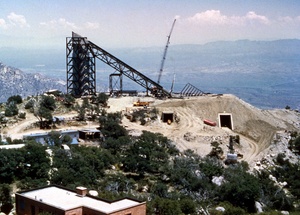 Construction of Solar Telescope (NOAO)
Construction of Solar Telescope (NOAO)
On March 15, 1960 KPNO was dedicated as the country’s first national observatory. The ceremony was attended by roughly 50 scientists, politicians, military officers, and Tohono O’odham nation members. The official address was delivered by Professor of Astronomy at the University of Chicago, William M. Morgan (Ramon-Sauberan 2018).
Relationship Between KPNO and the Tohono O’odham Nation
Description and understanding of the relationship between KPNO and the Tohono O’odham Nation and people and more specifically the ways in which the KPNO lease was granted has been largely dependent on group membership. In the years following the agreement, the scientists of KPNO described the process of coming to an agreement and the subsequent relations as simple and easy. The official, popular narrative of this history was that the agreement was unanimous, made quickly, and motivated by financial incentives. However, this is more than likely a mischaracterization (Malpas 2020).
The intricacies of the agreement are obscure, but it seems to be fairly complicated. The land on which KPNO was constructed is of great religious, ceremonial, and cultural importance to the Tohono O’odham people. Before it was named Kitt Peak by European settlers, it was Iolkam Du’ag, which is the name still used by Tohono O’odham people (Malpas 2020). They understand the mountain to be the garden of I’itoi, the creator of life. The mountain is the second most sacred peak in the area . There is evidence that Tohono O’odham people did not agree upon the lease unanimously; opinions were most likely divided in the Nation. The Tohono O’odham Nation rejected drafts of the lease twice and formally discussed prohibiting people outside of their Nation from entering any caves near the summit (de los Reyes 2019). Some Tohono O’odham people have negated the popular historical narratives regarding the site, such as Bernard Siquieros the then education curator at the Tohono O’odham Nation Cultural Center & Museum in Topawa. He argued that the elders who agreed upon the lease were not driven by financial gains, but instead for a way to educate and employ tribal members (Ramon-Sauberan 2018).
The 2005 Lawsuit
Relations between KPNO and the Tohono O’odham Nation rapidly deteriorated in 2005 with the start of construction for the Very Energetic Radiation Imaging Telescope Array System (VERITAS).
In March 2005 the Tohono O’odham Nation filed a lawsuit in US District Court against the National Science Foundation. They sought an injunction to immediately halt the construction of the VERITAS project on Kitt Peak and requested that the Bureau of Indian Affairs terminate the lease for KPNO. The Tohono O’odham Nation argued that the NSF violated the National Historic Preservation Act. They claimed that the NSF manipulated the environmental assessment process necessary to begin construction of their $13 million venture which resulted in the mountain not being declared a sacred site (Arizona Daily Star 2005). Because of this, other violations, and what they understood as unfair and dishonest representation of their interests in the meeting leading up to the lease agreement, they argued that the lease agreement should be voided (Malpas 2020).
The O’odham people were successful in preventing the VERITAS project from being constructed and it was moved to another site. They were not successful in their efforts to terminate the lease agreement and it is still currently in effect (Malpas 2020).
Following resolutions, KPNO increased outreach efforts to the Tohono O’odham Nation. The observatory now preferentially hires tribal members, hosts educational outreach programs for the O'odham, and sells O’odham crafts in the visitor center (de los Reyes 2019).
 Mural at KPNO painted by Tohono O'odham artist Mike Chiago (MDM Observatory)
Mural at KPNO painted by Tohono O'odham artist Mike Chiago (MDM Observatory)
Brief History of Management
The National Science Foundation (NSF) supports the observatories located on Kitt Peak. In 1957 the NSF entered into a contract with the Association of Universities in Astronomy Inc. for the operation of KPNO as a national center for optical astronomy. In 1982 the National Optical Astronomy Observatories was formed consolidating the management of the three national ground based optical observatories: KPNO, the National Solar Observatory with facilities on Kitt Peak and Sacramento Peak, and the Cerro Tololo Inter-American Observatory in Chile. The headquarters for the NOAO was located in Tucson (KPNO FAQ Page). The name NOAO is now retired. In 2019 KPNO became part of the the NSF National Optical-Infrared Astronomy Research Laboratory that includes all the nighttime astronomy observatories supported by the NSF (Howell 2014).
Telescopes and Scientific Discoveries
There are currently three major major nighttime telescopes, 22 optical telescopes, and two radio telescopes operated at KPNO (Howell 2014)
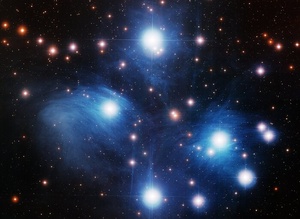 Pleiades captured by the WIYN telescope (NOIRlab)
Pleiades captured by the WIYN telescope (NOIRlab)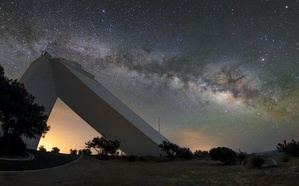 The Milky Way over the McMath telescope (NOIRlab)
The Milky Way over the McMath telescope (NOIRlab) HFG1 captured by Mayall telescope (NOIRlab)
HFG1 captured by Mayall telescope (NOIRlab) Messier 106 capture by Mayall telescope (NOIRlab)
Messier 106 capture by Mayall telescope (NOIRlab)
The Mayall 4-meter telescope at KPNO was dedicated in 1973. It is the largest optical telescope on Kitt Peak and has hosted a wide variety of instrumentation. It has played a major role in “establishing the the role of dark matter in the universe through observations of rotation curves in galaxies, in determinations of stellar radii from occultations, in understanding the dynamical structure of elliptical galaxies, and in determinations of the distance scale and large scale structure of the universe” (NOAO Mayall Telescope). It is housed in a notable 14-story cylindrical building (Howell 2014)
 Mayall Telescope (NOAO)
Mayall Telescope (NOAO)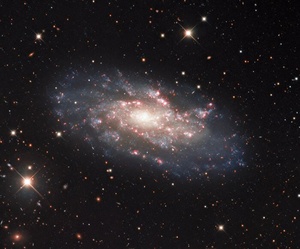 Spiral Galaxy NGC 2541 snapshot from Mayall Telescope (NOIRlab)
Spiral Galaxy NGC 2541 snapshot from Mayall Telescope (NOIRlab)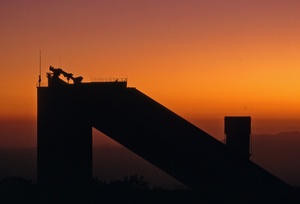 The McMath and Vacuum Telescopes (NOAO)
The McMath and Vacuum Telescopes (NOAO) Cept OB 3b captured by WIYN telescope (NOIRlab)
Cept OB 3b captured by WIYN telescope (NOIRlab)
The McMath-Pierce Solar Telescope was dedicated in 1962. When it began operation it was the largest solar telescope in the world (Howell 2014). Some of the notable discoveries and works using this telescope include the detection of water and isotopic helium on the Sun and the first high resolution images at 1.6 and 10 microns. In 2018 KPNO began converting it into the Windows on the Universe Center for Astronomy Outreach dedicated to students and visitors. It was expected to take two years to complete and was provided $4.1 million from the NSF (Howell 2014).
 Solar Telescopes (NOAO)
Solar Telescopes (NOAO)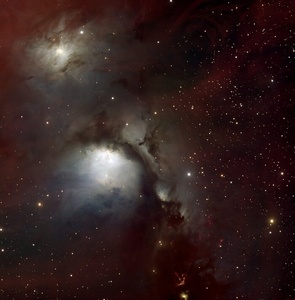 M78 captured with Mayall telescope (NOIRlab)
M78 captured with Mayall telescope (NOIRlab) Composite image of planetary nebula captured with WIYN telescope (NOIRlab)
Composite image of planetary nebula captured with WIYN telescope (NOIRlab)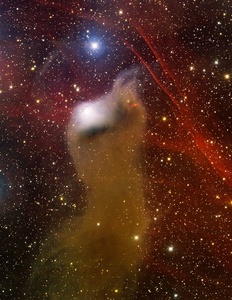 Barnard 175 (NOIRlab)
Barnard 175 (NOIRlab)
Astronomers at KPNO have also notably played a role in the charting of cosmic distances and studied faraway galaxies and Boötes void. In 2019, NASA and the NSF began a partnership in the search for exoplanets and began using the WIYN telescope located on Kitt Peak (Howell 2014).
 Ghost Nebula located in constellation Cepheus captured by Mayall telescope (NOIRlab)
Ghost Nebula located in constellation Cepheus captured by Mayall telescope (NOIRlab)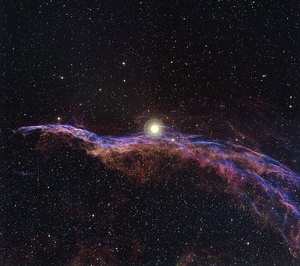 Veil Nebula captured by WIYN (NOIRlab)
Veil Nebula captured by WIYN (NOIRlab) Dumbbell Nebula captured by WIYN (NOIRlab)
Dumbbell Nebula captured by WIYN (NOIRlab)
Visitor Center Tours and Program
 Visitor's Center (NOIRlab)
Visitor's Center (NOIRlab) Visitor's Center (NOIRlab)
Visitor's Center (NOIRlab)
The Visitor Center at KPNO was established in 1964 and has since hosted over 2 million visitors (KPNO Visitor Center).
Visitors can go on self-guided tours of KPNO by purchasing available maps at the Gift Shop. They can walk around the grounds during normal operating hours and enter different facilities marked for visitor entrance. There are also guided tours offered three times a day. Each one of these tours visits one of the large historic telescopes located on Kitt Peak. VIP tours are also held by request or on the second Saturday of each month. These tours take goers on an extended behind the scenes look at telescopes not typically open to the public. They last up to five hours and involve extensive walking and climbing. The final type of tour they offer are for schools and private groups. They can be scheduled for 10 or more people and begin with a brief introduction followed by the McMath-Pierce solar telescope, Mayall 4-meter telescope, or the 2.1-meter telescope (Visitor Center Daytime Activities).
 Interior of Visitor Center (NOIRlab)
Interior of Visitor Center (NOIRlab)
Visitors can also participate in public solar observations using an array of telescopes specifically designed for Sun observation. Nighttime programs are also available including the Nightly Observing Program which is the most popular and typically runs all year. It introduces guests to the night sky through a variety of observing techniques. The Dark Sky Discovery Program is centered around telescopes. Participants observe a plethora of deep-sky objects in a small group setting. The Night of the Marvelous Moon Program is for guided Moon observations. Participants in this program learn to identify some of the more notable surface features of the Moon (Visitor Center Nighttime Programs).
Impact of the COVID-19 Pandemic
On March 19, 2020 all KPNO facilities were closed, including the road up the mountain. In mid October of the same year scientific operations with limited staff were reestablished. The focus has since been on the continuity of commissioned research using the Dark Energy Spectroscopic Instrument and the NEID instrument. A number of telescopes have also restarted limited nighttime operations (NOIRLab COVID-19 Measures 2021).
KPNO remains closed to all visitors. On September 27- October 4 the Remote Imaging Program was available by scheduled request. The telescopes used for this program were located in Colorado because they were without access to the ones located on Kitt Peak. KPNO said this program was to generate badly needed income. On October 6th the visitor center was closed indefinitely because of the financial impact of the pandemic (Remote Imaging Program). It is not certain when visitors will be allowed to return.
Sources:
Arizona Daily Star, "Kitt Peak Tension Calls for Intervention" 2005. https://web.archive.org/web/20080820093309/http://www.mauna-a-wakea.info/maunakea/H4_astrodev.html
de los Reyes, Mia. "A Tale of Two Observatories: Astronomy and Indigenous Communities in the Southwest US" 2019. https://astrobites.org/2019/08/16/a-tale-of-two-observatories/
Howell, Elizabeth, "Kitt Peak National Observatory: A Very Large Collection of Telescopes" 2014. https://www.space.com/26898-kitt-peak-facts.html#:~:text=Kitt%20Peak%20has%20three%20major,study%20of%20the%20sun%2C%22%20the
Kitt Peak Visitor Center, Daytime Activities. https://visitkittpeak.org/daytime/
Kitt Peak Visitor Center, Nighttime Programs. https://visitkittpeak.org/night-programs/
Kitt Peak Visitor Center, "Remote-Imaging Program" 2020. https://visitkittpeak.org/remote-imaging-program/
Malpas, Amelia, "Controversy at Kitt Peak" 2020. http://www.science.smith.edu/ast214/2020/05/01/controversy-at-kitt-peak/
NOAO, "Mayall 4-m Telescope on Kitt Peak" 1998. https://www.noao.edu/kpno/40th/4m.html
NOAO, "Photos of Kitt Peak Over 50 Years" 2009. https://www.noao.edu/kpno/history/reunion_slideshow/
NOAO "Frequently Asked Questions About Kitt Peak National Observatory" 2019. https://www.noao.edu/outreach/faq_kpno.html#5k
NOIRlab, Image Archive. https://noirlab.edu/public/images/?search=
Ramon-Sauberan, Jacelle "Kitt Peak National Observatory and Native Americans Go Way Back" 2018. https://indiancountrytoday.com/archive/kitt-peak-national-observatory-and-native-americans-go-way-back



